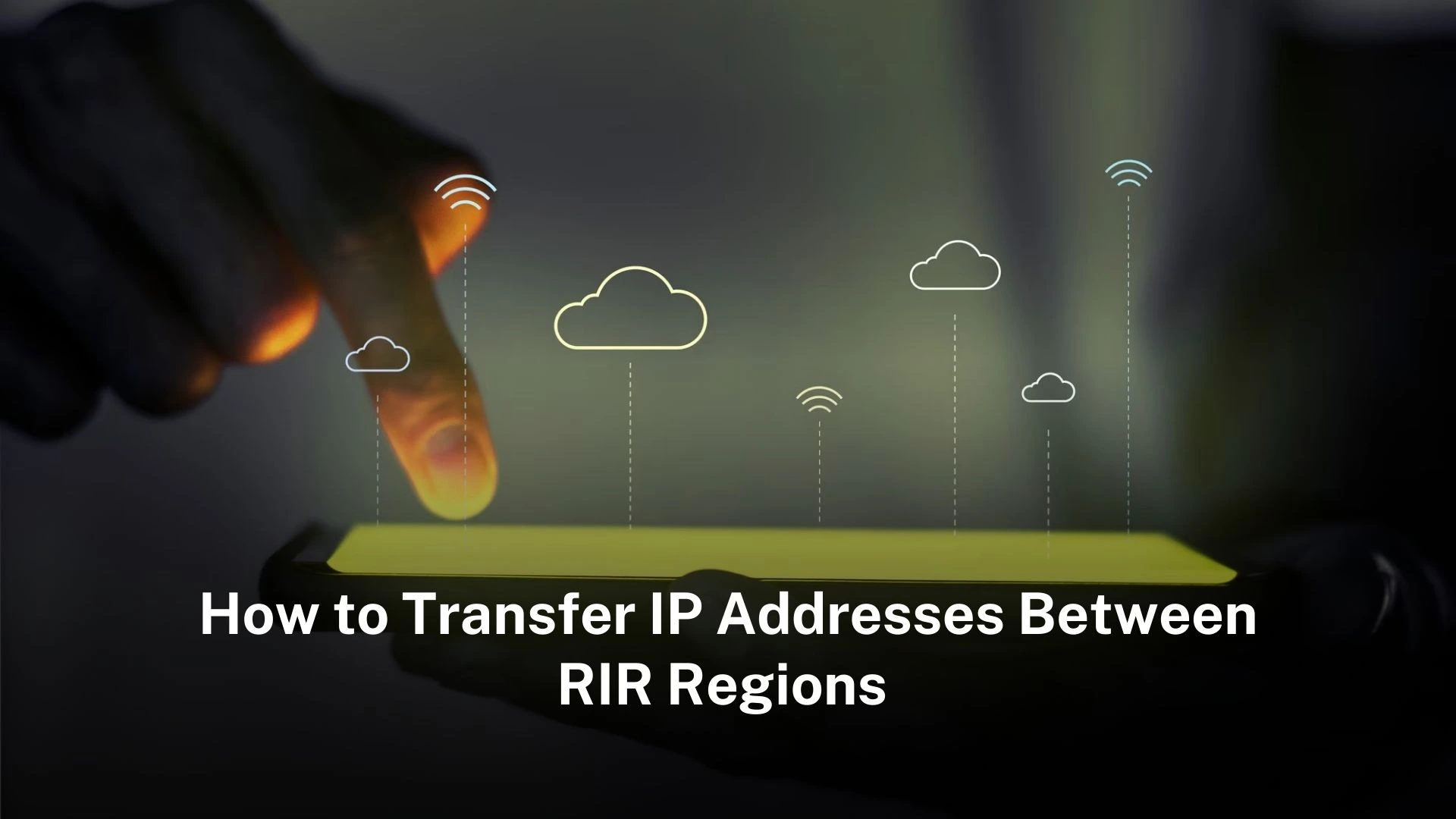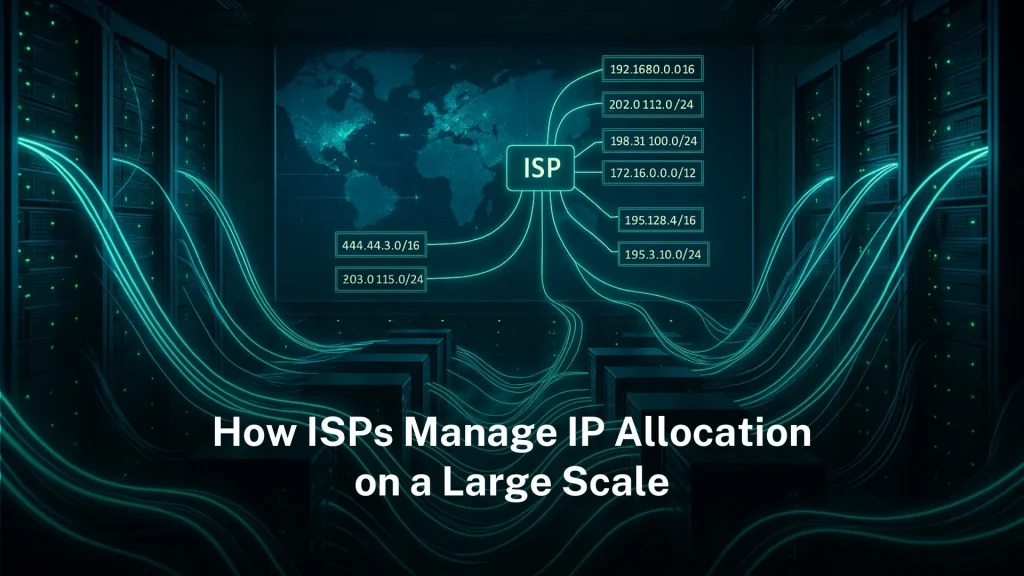Transferring IP addresses between Regional Internet Registry (RIR) regions is complex but crucial in today’s digital world. Businesses expand globally. Demand for IP addresses changes. Understanding how to handle these transfers is key. This article explains how to transfer IP addresses between RIR regions.
Standfirst
Transferring IP addresses between RIR regions involves policies, approvals, documentation and overcoming challenges.
Key Points
Each RIR has its own policy rules so inter-RIR transfers have different requirements.
The process needs approval from both the sending and receiving RIRs. It also needs careful documentation and checks to make sure rules are followed.
What are RIRs and Why Do IP Address Transfers Matter?
Regional Internet Registries manage the allocation and registration of internet number resources in specific world regions. These organizations act as custodians for IP addresses and related resources ensuring fair distribution and proper management across their areas. Their work is not just about giving out IP addresses. They keep detailed records of who owns which addresses monitor resource usage and update their databases regularly to show changes in ownership or allocation. This stops conflicts where multiple organizations might claim the same IP address which could break internet connections and cause widespread disruptions.
There are five main RIRs worldwide. IP address transfers between RIR regions matter for various reasons. Businesses expand across borders regularly. They often need IP addresses in new regions to support local operations maintain server connections and ensure smooth user experiences. A European e-commerce company that starts selling to customers in India will need IP addresses in the APNIC region to set up local data centers. This allows faster loading times for Indian customers as data doesn’t have to travel as far across the globe. It also helps the company comply with local data protection laws which often require data to be stored within the country using locally registered IP addresses.
A European company building a large customer base in Asia might need to transfer IP addresses from the RIPE NCC region to the APNIC region to host local websites run regional servers and comply with local digital regulations. Without such transfers the company might have to rely on IP addresses from its home region leading to slower service and potential legal issues. This could result in lost customers and damaged reputation in the new market.
IPv4 addresses have become increasingly scarce globally. Some regions have more available stock than others. Organizations in regions with shortages might seek transfers from regions with surplus to keep their services running without interruption. Parts of Europe and North America have been early adopters of the internet leading to a higher saturation of IPv4 addresses in these areas. In contrast some regions in Africa and Asia still have more IPv4 addresses available because their internet growth started later. Transfers allow organizations in saturated regions to acquire much-needed addresses from these less saturated areas delaying the need to switch to IPv6 which while necessary long-term requires significant technical upgrades and costs.
Dr. Jane Smith is a leading expert in internet governance. She notes “The ability to transfer IP addresses between RIR regions is crucial for the global internet’s growth and flexibility. It lets businesses and organizations adapt to changing digital situations and meet user needs without being limited by regional resource constraints.” This flexibility helps maintain the internet’s functionality as a global network connecting users and services across continents. It also supports innovation by allowing companies to scale their operations where demand exists rather than being restricted by IP address availability in specific regions.
The Process of Transferring IP Addresses Between RIR Regions
Step 1: Research and Understanding of Policies
The first step in transferring IP addresses between RIR regions is to research and understand both the sending and receiving RIRs’ policies. Each RIR has its own rules. These rules say who can transfer IP addresses what types can be transferred and any restrictions or requirements. The RIPE NCC has specific policies for IPv4 address transfers. It includes a 24-month holding period for some scarce resources before they can be transferred.
APNIC has its own rules. Its official website states “APNIC policy requires that the other regional internet registry must have a compatible transfer policy. Currently RIPE NCC, ARIN and LACNIC are the only eligible RIR regions for inter-RIR transfers.” An organization in the APNIC region wanting to transfer IP addresses to another region must check the receiving RIR has a compatible policy.
Step 2: Initiating the Transfer Request
Understanding policies comes first. Then start the transfer request. Usually the current IP address holder (in the sending RIR region) contacts their RIR to begin. In the ARIN region all transfer requests need an ARIN online account. This account must link to an admin or tech point of contact record with the right to request resources for a valid organization identifier. The requester logs into their ARIN online account selects “Transfer Resources” from the menu and follows the instructions.
In the RIPE NCC region inter-RIR transfers need the transferring party to complete the inter-RIR transfer template. They send an email with the request to inter-rir@ripe.net. They must provide certain documents for due diligence. These include a digital copy of a passport or valid ID for individuals and a confirmation letter of the transfer request signed by a company director authorized to act for the party.
Step 3: Approval and Coordination
Submitting the transfer request is next. Then both the sending and receiving RIRs review it for approval. This process checks if the request follows their policies. It verifies the parties’ identity and authority. It makes sure the transfer meets all requirements. An organization in the APNIC region receiving IP addresses from the RIPE NCC region will get contacted by APNIC. APNIC asks for reasons for the transfer after getting the request from RIPE NCC.
The two RIRs coordinate during this process. They share information about the transfer. This includes details of the IP addresses the parties involved and any relevant documents. This coordination is key for a smooth successful transfer.
Step 4: Documentation and Record-Keeping
Good documentation and record-keeping matter through the whole transfer process. Parties involved must track all communication requests approvals and fees. ARIN requires organizations to keep good records. This includes updating org ID and point of contact information and paying all annual registration renewal and maintenance fees. This makes sure the transfer process is transparent and accountable.
Step 5: Completion of the Transfer
Approval and meeting all requirements mean the transfer can be finished. This usually involves the RIRs updating their registries to show the new IP address owners. In the RIPE NCC region registering a transfer updates the internet number resources in the RIPE database. Transfer details get published on their website. The receiving organization can then use the transferred IP addresses following their RIR’s policies.
Common Challenges and How to Overcome
Policy Differences
Different policies are a big challenge in transferring IP addresses between RIR regions. Each RIR has its own rules making the process complex. Organizations must spend time researching and understanding both RIRs’ policies. They might get legal or technical help from experts who know about inter-RIR transfers.
Documentation Requirements
Lots of documentation can be a challenge too. Organizations need all necessary documents in the right format. Making a checklist of required documents and gathering them early helps. This avoids delays and makes the transfer smooth.
Fee Structure
The cost of IP address transfers is another challenge. Different RIRs have different fee models. Organizations must know these costs.
Step 1: Research and Understanding of Policies
The first step in transferring IP addresses between RIR regions is to research and understand both the sending and receiving RIRs’ policies. Each RIR has its own rules. These rules say who can transfer IP addresses what types can be transferred and any restrictions or requirements. The RIPE NCC has specific policies for IPv4 address transfers. It includes a 24-month holding period for some scarce resources before they can be transferred.
APNIC has its own rules. Its official website states “APNIC policy requires that the other regional internet registry must have a compatible transfer policy. Currently RIPE NCC, ARIN and LACNIC are the only eligible RIR regions for inter-RIR transfers.” An organization in the APNIC region wanting to transfer IP addresses to another region must check the receiving RIR has a compatible policy.
Step 2: Initiating the Transfer Request
Understanding policies comes first. Then start the transfer request. Usually the current IP address holder (in the sending RIR region) contacts their RIR to begin. In the ARIN region all transfer requests need an ARIN online account. This account must link to an admin or tech point of contact record with the right to request resources for a valid organization identifier. The requester logs into their ARIN online account selects “Transfer Resources” from the menu and follows the instructions.
In the RIPE NCC region inter-RIR transfers need the transferring party to complete the inter-RIR transfer template. They send an email with the request to inter-rir@ripe.net. They must provide certain documents for due diligence. These include a digital copy of a passport or valid ID for individuals and a confirmation letter of the transfer request signed by a company director authorized to act for the party.
Step 3: Approval and Coordination
Submitting the transfer request is next. Then both the sending and receiving RIRs review it for approval. This process checks if the request follows their policies. It verifies the parties’ identity and authority. It makes sure the transfer meets all requirements. An organization in the APNIC region receiving IP addresses from the RIPE NCC region will get contacted by APNIC. APNIC asks for reasons for the transfer after getting the request from RIPE NCC.
The two RIRs coordinate during this process. They share information about the transfer. This includes details of the IP addresses the parties involved and any relevant documents. This coordination is key for a smooth successful transfer.
Step 4: Documentation and Record-Keeping
Good documentation and record-keeping matter through the whole transfer process. Parties involved must track all communication requests approvals and fees. ARIN requires organizations to keep good records. This includes updating org ID and point of contact information and paying all annual registration renewal and maintenance fees. This makes sure the transfer process is transparent and accountable.
Step 5: Completion of the Transfer
Approval and meeting all requirements mean the transfer can be finished. This usually involves the RIRs updating their registries to show the new IP address owners. In the RIPE NCC region registering a transfer updates the internet number resources in the RIPE database. Transfer details get published on their website. The receiving organization can then use the transferred IP addresses following their RIR’s policies.
FAQs
1. Can any type of IP address be transferred between RIR regions?
Not all IP addresses can be transferred. Each RIR has rules about which types can be transferred. Some RIRs restrict transferring scarce resources like IPv4 addresses. Check both RIRs’ policies before trying to transfer.
2. How long does the IP address transfer process between RIR regions take?
The time varies. It depends on transfer complexity how quick the parties are and the RIRs’ approval processes. It can take a few weeks to several months. Start the process well before needing the transferred IP addresses.
3. Do I need to be a member of a specific RIR to transfer IP addresses?
Membership requirements vary by RIR. Some need parties to be members others have different rules. In the RIPE NCC region some transfers might only happen between RIPE NCC members. Check the relevant RIRs’ membership and eligibility rules.
4. What happens if the transfer request is rejected?
A rejected transfer request usually comes with reasons from the RIR. The parties can look at these reasons and take action. They might provide more documents fix policy issues or rethink the request. Appealing the rejection might be possible depending on the RIR’s policies.
5. Are there any security implications associated with IP address transfers between RIR regions?
IP address transfers can have security issues if not done right. The transfer process must have good security measures. These include checking parties’ identity and authority protecting sensitive information and ensuring the transferred IP addresses are secure. Organizations should think about their RIRs’ security policies and relevant industry standards.










Leave a Reply